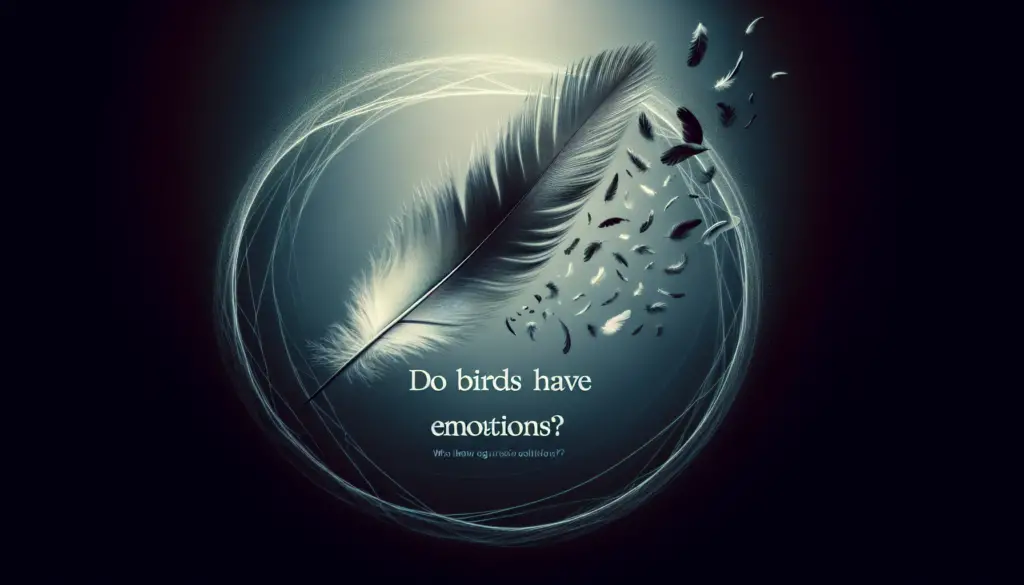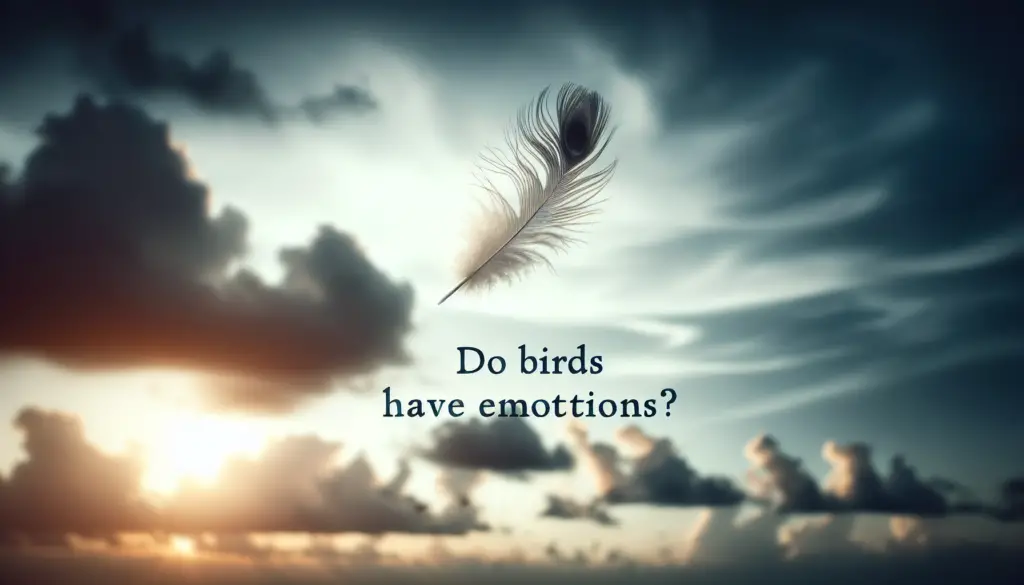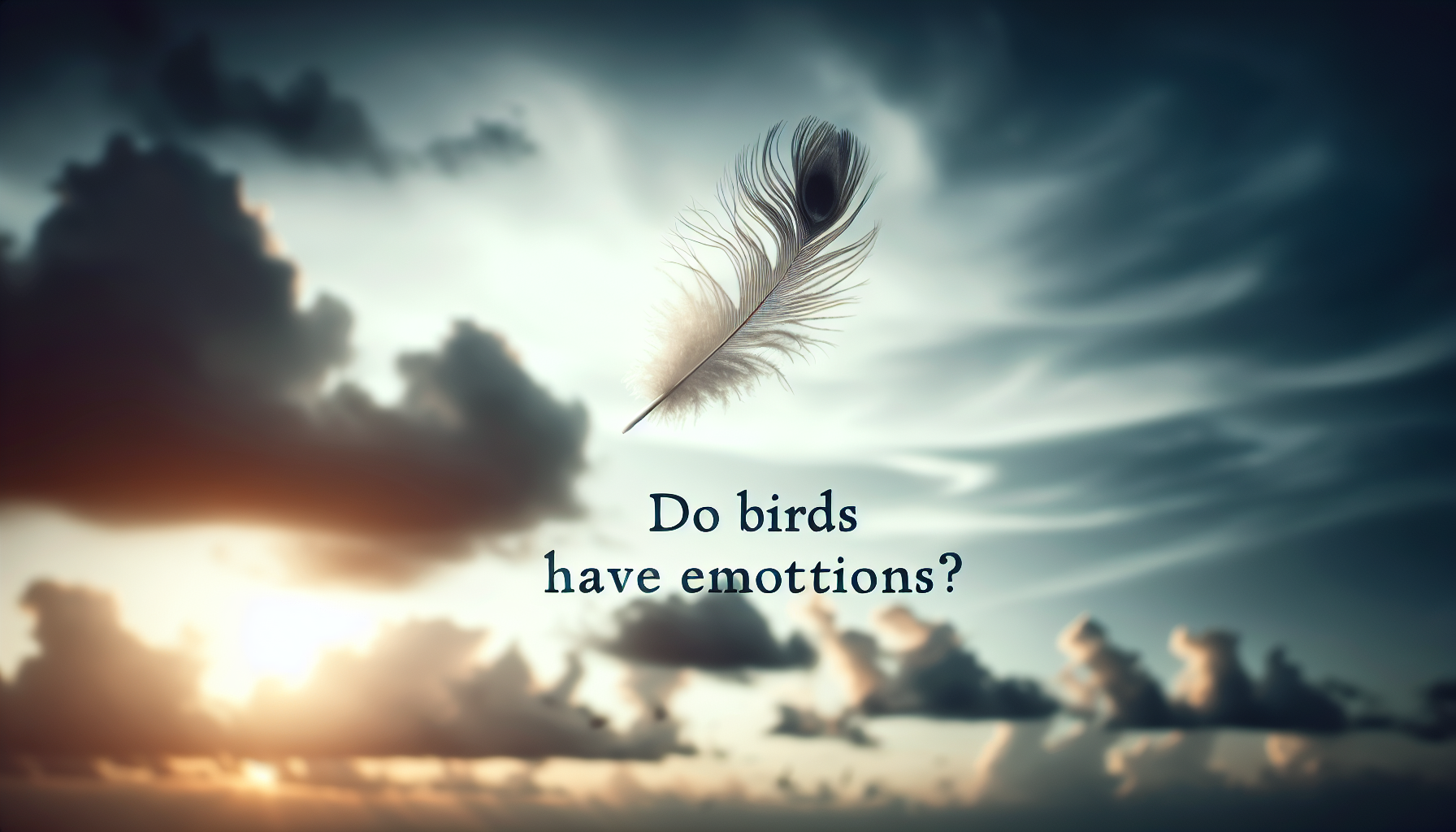Have you ever wondered if birds have emotions? It’s a question that has captivated researchers and bird enthusiasts alike. From their melodious songs to their intricate dances, birds seem to display behaviors that hint at a deeper emotional life. But do they truly experience emotions? In this article, we will explore the fascinating world of bird emotions and uncover the surprising findings that shed light on this intriguing question. Prepare to be amazed by the inner lives of our feathered friends!

Understanding Emotions
Defining Emotions
Emotions are complex psychological states that involve a combination of physiological arousal, subjective experiences, and behavioral expressions. They play a fundamental role in our lives, influencing our thoughts, actions, and interactions with others. Emotions can be triggered by various internal and external factors, ranging from personal experiences to environmental stimuli. They are an integral part of the human experience and contribute to our overall well-being.
Types of Emotions
Emotions encompass a wide range of feelings, each serving a different purpose. Common emotions include happiness, sadness, anger, fear, surprise, disgust, and love. These emotions can be further categorized as either positive or negative, depending on their valence. Positive emotions such as joy, gratitude, and contentment are associated with pleasant experiences, while negative emotions like sadness, anger, and fear are linked to unpleasant or challenging situations. Understanding the different types of emotions can help us navigate and respond to various circumstances in a more effective manner.
The Link Between Emotions and Behavior
Emotions have a profound impact on our behavior. They influence how we perceive and interpret the world around us, shaping our thoughts and guiding our actions. When experiencing positive emotions, we tend to be more approachable, sociable, and open-minded. Conversely, negative emotions can lead to withdrawal, aggression, or avoidance. Our behavior can be influenced by both conscious and subconscious emotional processes. Recognizing and managing our emotions is crucial for maintaining healthy relationships, making sound decisions, and promoting overall psychological well-being.
Emotions in Animals
Debating Animal Emotions
The existence of emotions in animals has been a topic of debate among scientists and researchers. While the ability to experience emotions was long considered to be exclusive to humans, recent findings suggest that animals, including birds, may also possess emotional states. However, the exact nature and extent of these emotions are still being explored and understood.
Recognizing Emotions in Animals
Recognizing emotions in animals can be challenging since they cannot express their feelings through language as humans do. However, by closely observing their behaviors, reactions, and physiological changes, researchers have been able to identify potential emotional states. For example, signs of fear may include increased heart rate, widened eyes, or attempts to flee, while happiness may be expressed through joyful vocalizations, playful behaviors, and relaxed body postures.
Research on Animal Emotions
Researchers have conducted numerous studies to investigate the emotional lives of animals, including birds. These studies often examine behavioral responses, brain activity, hormone levels, and neurochemical processes associated with emotions. By analyzing these indicators, scientists have gained valuable insights into the emotional capacities of animals and have begun to unravel the intricate relationship between emotions and behavior in the animal kingdom.
Bird Behavior
Complexity of Bird Behavior
Birds exhibit an astonishingly diverse range of behaviors, demonstrating their remarkable adaptability and intelligence. From complex migration patterns to intricate courtship displays, the behavior of birds is both fascinating and multifaceted. Different bird species display unique behaviors that are influenced by a combination of genetics, environmental factors, and social interactions.
Bird Communication
Communication plays a vital role in bird behavior, enabling them to convey information, establish social hierarchies, and form bonds. Birds communicate through a variety of vocalizations, body postures, and visual displays. Examples include melodic songs, territorial calls, mating dances, and even mimicry of other species. This intricate communication network allows birds to relay important messages and maintain social cohesion within their communities.
Parental Care
Birds, like many other animals, exhibit various forms of parental care to ensure the survival and well-being of their offspring. Parental behavior can include activities such as nest building, incubating eggs, provisioning food, and protecting the nest from predators. The level of parental investment varies among bird species, with some showing high levels of dedication and others exhibiting minimal involvement. These behaviors are driven by a combination of instinctual drives, hormonal changes, and learned behaviors.
Mating Rituals
Mating rituals in birds are often elaborate and visually striking. Male birds may engage in intricate courtship displays to attract a mate, showcasing their physical prowess, vibrant plumage, or unique vocal abilities. These rituals serve multiple purposes, including demonstrating fitness, establishing pair bonds, and ensuring successful reproduction. Mating rituals can vary significantly among bird species, presenting a fascinating array of behaviors to witness and study.

Evidence of Emotions in Birds
Observational Studies
Observational studies have provided valuable insights into the emotional lives of birds. Researchers have documented behaviors that suggest the existence of emotions, such as apparent grief, joy, fear, and aggression. These observations often involve closely monitoring changes in behavior, vocalizations, social interactions, and physiological responses. While these studies cannot definitively prove the presence of emotions, the consistent patterns observed suggest a strong likelihood of emotional experiences in birds.
Neurobiology Studies
Neurobiology studies have explored the neural mechanisms underlying emotional processes in birds. By examining brain structures, neural pathways, and neurochemical activity, researchers have identified similarities between avian and mammalian brain regions involved in emotional processing. This suggests that birds may possess similar neural substrates for emotional experiences, further supporting the idea that they can indeed experience emotions.
Experimental Research
Experimental research has also shed light on the emotional capacities of birds. Through controlled experiments, scientists have manipulated aspects of the environment or introduced stimuli to evoke specific emotional responses in birds. These experiments have allowed researchers to study the behavioral, physiological, and cognitive reactions associated with different emotional states. While ethical considerations are paramount in such studies, they have provided valuable insights into the emotional complexities of avian species.
Fear and Anxiety
Flight Response
Birds often exhibit a flight response when faced with perceived threats or danger. This innate survival mechanism helps them escape potentially harmful situations quickly. When a bird senses danger, it may take flight, often characterized by rapid wing flapping, agile maneuvers, and the search for safety. This instinctual response is indicative of fear and demonstrates the avian ability to experience and respond to negative emotions.
Recognition of Threats
Birds possess the ability to recognize and respond to threats in their environment. Their acute senses, such as vision and hearing, allow them to detect potential dangers, including predators or unfamiliar circumstances. Upon perceiving a threat, birds may exhibit behaviors such as alarm calls, increased vigilance, or attempts to escape. These reactions suggest a heightened level of awareness and the presence of emotions related to fear and anxiety in birds.
Avoidance Behavior
To minimize potential risks, birds may engage in avoidance behavior when encountering threatening stimuli. This can involve altering their flight path, changing their foraging locations, or avoiding areas where they have previously encountered danger. Avoidance behavior is a strategic response that reflects the ability of birds to assess and regulate their emotional experiences, thereby increasing their chances of survival.
Pleasure and Happiness
Play Behavior
Birds, particularly young individuals, often engage in play behavior, displaying joy and pleasure. This behavior includes activities such as aerial acrobatics, social games, or object manipulation. Play behavior can serve various purposes, including developing physical abilities, practicing social skills, and simply experiencing enjoyment. The presence of play behavior in birds suggests the existence of positive emotions and highlights their ability to experience pleasure and happiness.
Feeding and Foraging
Feeding and foraging are essential activities for birds, and they often derive pleasure from obtaining and consuming food. Birds may exhibit excitement, anticipation, and satisfaction while engaging in successful foraging behavior. The reward associated with finding a food source contributes to their overall well-being and reinforces positive emotions. This connection between feeding and pleasure further supports the notion that birds experience emotions related to happiness.
Social Interactions
Birds are highly social creatures and engage in a wide range of social interactions with conspecifics. Social bonding, courtship displays, and cooperative behaviors all play a role in their social dynamics. Positive social interactions, such as mutual grooming, allopreening, or flocking, are likely to elicit feelings of pleasure and happiness, as they foster social cohesion and strengthen group bonds. The presence of positive emotions in birds is evident in their social interactions and further demonstrates their capacity for emotional experiences.
Grief and Mourning
Responses to Death of a Mate
Evidence suggests that birds may experience grief and mourning when their lifelong mate passes away. Observational studies have documented behaviors such as withdrawal, decreased vocalizations, reduced appetite, and prolonged periods of solitude in birds that have lost their partner. These grief-like responses are indicative of mourning and highlight the emotional bonds formed between avian mates.
Responses to Loss of Offspring
Birds also exhibit distress and mourning-like behaviors when faced with the loss of their offspring. They may vocally and physically express their grief, engage in protective behaviors towards the deceased chick, or show signs of depression. These responses demonstrate the emotional attachment and parental investment birds have towards their offspring, reinforcing the presence of grief and mourning in their emotional repertoire.
Bonding and Attachment
Pair Bonding
Pair bonding refers to the formation of long-term relationships between mates in birds. This bond serves various functions, including mate selection, cooperative breeding, and enhancing reproductive success. Birds that are pair-bonded often engage in mutual grooming, nest building, and coordinated territorial defense. This strong partnership demonstrates the emotional attachment and social bond formed between avian mates.
Parent-Offspring Bonding
Parent-offspring bonding is vital for the survival and development of young birds. Parents invest significant time and resources in nurturing and protecting their offspring until they become independent. This bonding process involves feeding, brooding, teaching essential skills, and defending the nest from potential threats. The emotional connection between parents and offspring is crucial for the successful rearing of offspring and highlights the presence of attachment and bonding in bird species.
Group Cohesion
Many bird species form cohesive groups, such as flocks or colonies, where individuals work together to increase their chances of survival and reproduction. These social structures rely on the emotional bonds and cooperative behaviors exhibited among group members. Cohesion within these groups can be maintained through various means, including synchronized flight patterns, cooperative foraging, and collaborative predator defense. The emotional connections within bird communities contribute to their overall cohesiveness and highlight the importance of social bonds in avian societies.
Empathy and Compassion
Helping Behavior
Empathy, or the ability to understand and share the emotions of others, is a complex trait observed in many species, including birds. Birds have exhibited helping behavior towards injured or distressed individuals, providing support and assistance. In some cases, birds have been observed sharing food or engaging in protective behaviors towards those in need. This behavior suggests the presence of empathy and compassion, as birds display care and concern for their conspecifics.
Support Within a Group
Birds living in cohesive groups often provide social support to one another. Mutual grooming, allopreening, and coordination during navigation or foraging are examples of behaviors that reinforce social cohesion and foster group survival. By offering support and assistance to other group members, birds demonstrate their capacity for empathy and compassion, contributing to the overall well-being of the community.
Disputes and Anger
Territorial Defense
Birds often engage in territorial defense to protect their nesting sites, feeding grounds, or mating territories. This behavior is driven by a sense of ownership and the need to maintain exclusive access to vital resources. Aggressive displays, such as vocalizations, posturing, or physical confrontations, are common during territorial disputes. These behaviors reflect the avian ability to experience anger and assert dominance to ensure their survival and reproductive success.
Aggressive Displays
Birds may exhibit aggressive displays towards conspecifics, primarily during courtship or competition for resources. These displays can involve vocalizations, physical gestures, or overt aggression, such as pecking or wing beating. Aggression in birds represents their emotional response to intrusions or challenges and serves to establish social hierarchies and secure access to essential resources.
Social Hierarchies
Within bird communities, social hierarchies often develop, shaping interactions and relationships among individuals. Hierarchies are determined through competitive encounters and aggressive displays, in which dominant individuals establish their rank and submissive individuals conform to a lower position. The formation of social hierarchies and the subsequent establishment of dominance reflect the avian capacity for disputes and anger, regulating social dynamics within the group.
In conclusion, birds exhibit a remarkable array of emotions, reflecting their complex cognitive and emotional capacities. Through observational studies, neurobiology research, and experimental investigations, scientists have gained valuable insights into the emotional lives of birds. From fear and anxiety to pleasure and happiness, grief and mourning to bonding and attachment, and even empathy and compassion, birds demonstrate a range of emotional experiences that parallel those observed in humans and other animals. Understanding and acknowledging the emotional lives of birds enhances our appreciation for their complexity and reinforces the need for their protection and welfare.

My name is Shane Warren, the author behind Your Bird Buddy – your ultimate guide to the wonderful world of birds! Unleash your inner avian explorer as we delve into a vibrant library of knowledge dedicated to all things feathered. From learning about diverse bird species from across the globe to understanding their captivating habitats and behaviors, I’m here to fuel your passion for these magnificent creatures. Not only that, but I also provide valuable insights on being a responsible and informed pet bird owner. Join our vibrant community and let’s celebrate the feathered wonders of the world together – one chirp at a time. And be sure to join our Your Bird Buddy Community over on Facebook!


Comments are closed